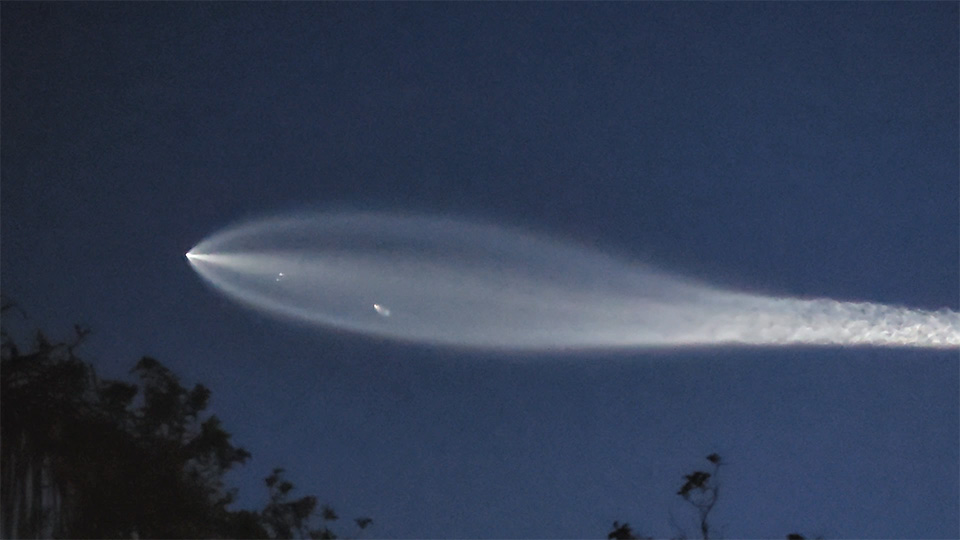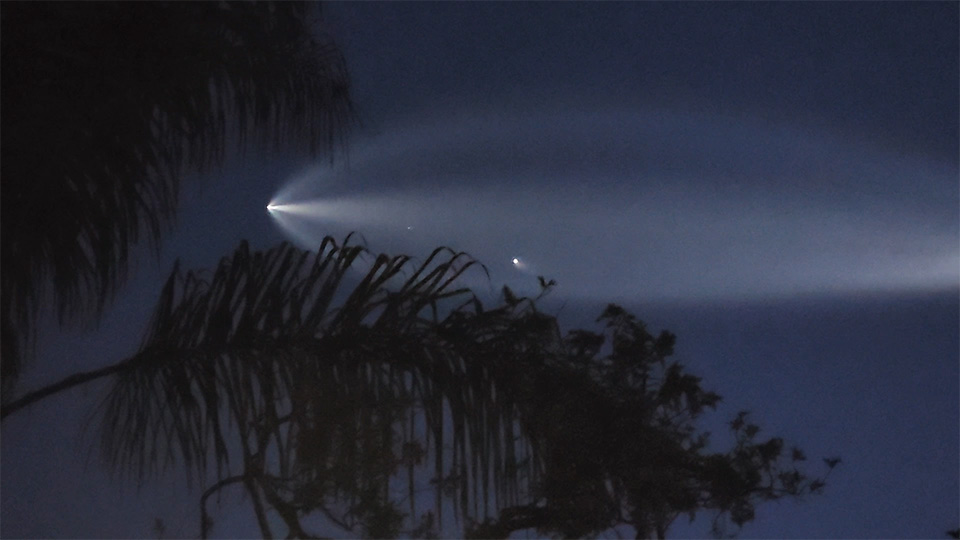the neighborhood turned out for a twilight falcon launch (click on the arrow twice to start the video--the audio is priceless):
first stage shut off:
second stage cruising:
 |
| the two small trailing dots are the fairings and the third further back is the first stage the first stage will land on a barge and the fairings recovered at sea |
second stage poofing out:
into the palm trees:
late second stage between the trees and into space:
(cloudy nights is the ultimate web site for amateur astronomy, sponsored by astronomics)
while you may or may not want the iconic grey shirt
the "pitches" on the web site are priceless with the writer channeling J Peterman
so for all you fans of Seinfeld and astronomy (you know who your are)
you must go to the web site and check out the pitches
https://astronomics.com/collections/cloudy-nights-t-shirts/products/cloudy-nights-short-sleeve-t-shirt
6/16/25 8:41-8:44 PM local
Eastbluff, CA
Samsung galaxy S22 ultra
"come here quick..."
then softly as if to avoid disturbing the rocket
"...it's right over our house"
First try...
The Cloudy Nights T-Shirt
(Now with 47% more mystique.)
It was the spring of 1997. Somewhere between the Mojave and a memory, a man named Skip Donnelly sat cross-legged in the back of a rust-orange VW van, peering through a hand-polished 6" Newtonian and waiting for Hale-Bopp to clear the horizon.
He hadn’t slept in three nights. He’d been living off gas station trail mix and a dream. His only companion? A local coyote who seemed to admire his collimation skills.
Skip wore this shirt—or one eerily similar.
It’s Graphite Heather, though he’d just call it “night sky gray.” Softstyle fabric with the kind of 65/35 poly-cotton blend you could sleep in on a moonlit truck bed. It absorbed both dew and regret in equal measure. By morning, the comet came. Bright. Relentless. Eternal.
Skip wept.
He never made it back to Phoenix. Some say he followed the comet, westbound. Others claim he founded a secret astronomy club in Taos that meets only during solar minimum.
We can’t say for sure. But we can say this:
You don’t just wear the Cloudy Nights T-Shirt.
You inherit it.
Second try...
The Cloudy Nights T-Shirt
It was 2:17 a.m. in the high desert of New Mexico.
A lonely astronomer stood beside his Dobsonian like a sentry, hand wrapped around a thermos of coffee that had long since gone cold. Above him, Saturn hovered like a jeweled ringbox in a sea of ink. His fingers trembled—not from the chill, but from awe. And the shirt he wore? It wasn’t just a shirt. It was a declaration.
This is that shirt.
Crafted from a supple blend of 65% polyester and 35% cotton, this Graphite Heather short sleeve garment has seen things—cosmic things. It breathes like a mountain breeze and fits like the warm memory of your first clear sky chart. The logo is discreet, like a secret handshake at a Messier Marathon. The fit is modern, but forgiving. The cut, understated but purposeful.
Available in sizes Small through 4XL for observers of every focal length and flange distance.
You don’t just wear the Cloudy Nights T-Shirt.
You live in it.
And now the one that makes sense to just about everyone.
Cloudy Nights Short Sleeve T-Shirt – Graphite Heather
Show your love for late nights, clear skies, and the community that helps you navigate them both. This official Cloudy Nights t-shirt is printed on a soft, breathable Gildan Softstyle tee in a versatile Graphite Heather color. Whether you’re polar aligning at dusk or just grabbing coffee in town, it’s a comfortable way to rep the world’s largest astronomy forum.
Made from a durable 65/35 polyester-cotton blend, this shirt holds its shape and stays comfortable through long nights and many washes. Lightweight, soft, and just structured enough to keep from looking like a wrinkled star chart.
Available in sizes Small through 4XL—because we support big scopes and big style alike.

























